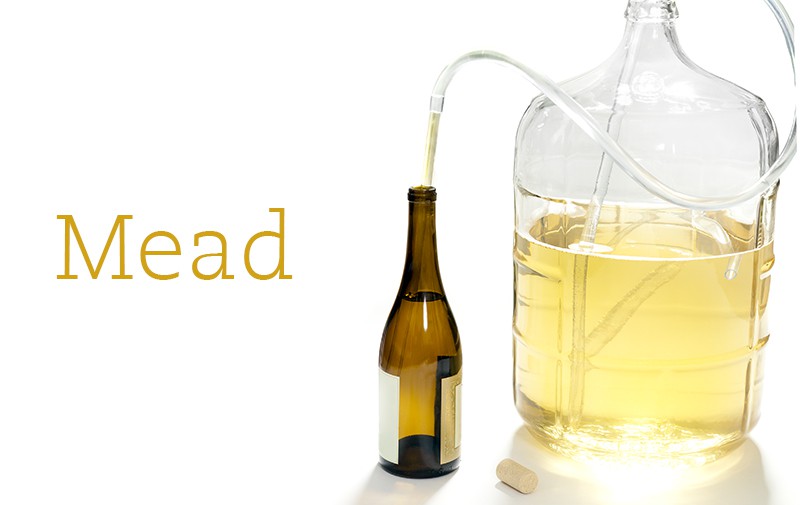
We’ve enjoyed the fruits of bees’ labor for a long, long time, and I’m not talking about the bear-shaped squeeze bottles at the grocery store. Honey has been the sweet treat for the human race for more than ten thousand years. And as with many of nature’s treasures—grapes and grains, for instance—it didn’t take us very long to convert honey to alcohol, creating a magical potion known as mead.
In fact, it’s likely that mead, or honey wine as it’s sometimes called, was the original fermented beverage. But the origins of mead are somewhat clouded in mystery, since the stuff was likely around before anyone could record its discovery. When the written word finally caught up to the honey beverage, it gained a mention in early religious texts around 1700 B.C. Aristotle and Plato would later note some good times with mead in their writings. Chaucer and Shakespeare, too, confirm that honey wine was a staple beverage in their days. The term honeymoon even refers to a medieval practice in which newlyweds would drink mead to help promote fertility.
While mead today may still carry the stigma of a drink for Renaissance fairs, it should be noted that Americans are making some highly coveted small-batch meads. There are roughly 60 commercial meaderies currently operating in the United States, many of which compete in an annual contest at the International Mead Festival in Denver, Colorado. Despite the varying style guidelines for this competition, the ingredients in question haven’t varied one iota since mead’s early days. Plain and simple, mead is made from honey, water, and yeast. Different classifications of mead, however, will introduce adjuncts into the mix. Pyment is mead fermented with grapes. Metheglin is mead made with herbs and spices. Melomel is mead with berries. Cyser is mead made with apple cider. The stuff can be sweet or dry, still or sparkling. It can have notes of warming alcohol (14 to 18 percent) or can be downright gulpable. Just like a grape varietal dictates the flavor and color of a wine, honeys from different flowers can define a mead’s terroir. If the honey comes from bees that have been pollinating orange blossoms, for instance, the mead may have wonderful aromas of vibrant citrus.
There are many meaderies that harvest their own honey on-site, much like a farmstead cheesemaking operation collects its own milk. This allows the mead maker to place hives near desired flora, allowing endless creativity in recipe formulation. Many well-established meaderies also source their honey from local beekeepers that offer unique flavors. The honey is then mixed with water and any desired fruits, herbs, and spices to create a concoction called must. The must is heated to both pasteurize the mixture and infuse flavors. After the must has been cooked, it is cooled and yeast is introduced to begin the fermentation process. The mead is checked often during this stage to ensure that the yeast is doing its job of converting the sugars in the must to alcohol. When the mead is finished fermenting, it is added to a secondary tank to age before bottling. Depending on the desired mead, both the aging time and vessel vary. Some meaderies use stainless-steel tanks, while others have begun employing toasted oak, bourbon, or wine barrels.
If done correctly, the resulting beverage shows hints of what the bees have been up to: you can decipher whether they were hanging around a field of lavender or an orchard or a mountain meadow. And no matter what the bees have been pollinating, with one taste of American craft mead, you’ll begin to understand how honey wine garnered the moniker “Nectar of the Gods.”
Wild Blossom Meadery and Winery Blanc de Fleur and Redwood Hill Farm Camellia
Beekeeper and mead maker Greg Fischer checks in on 80 beehives scattered around lakeside dunes, Midwest prairies, and even urban haunts of Chicago. As a result, Fischer has a variety of local honeys to work with when back at the meadery. His Blanc de Fleur utilizes honey made from prairie wildflowers to create a crisp mead reminiscent of a dry Riesling. The honey comes through with a floral nose and finishes with a dry fruitiness, making this mead perfect for cutting through a rich, bloomy-rind cheese like Camellia. Jennifer Bice of Redwood Hill Farm and Creamery is celebrating her 41st year of breeding and milking dairy goats, and she just happens to make one of the best goat’s milk Camembert-style cheeses in the country.
Redstone Meadery Mountain Honey Wine and Sweet Grass Dairy Thomasville Tomme
David Myers, founder of Redstone Meadery and unofficial spokesman of American mead, has expanded his company’s reach to more than 20 states, making Redstone Meadery one of the largest in the country. His juniper Mountain Honey Wine is created from two parts orange blossom honey and one part desert blossom honey. The pale, straw-colored mead starts off a little sweet but gives way to earthy, oaky vanilla undertones and a clean finish. Sweet Grass Dairy, a family-owned farm and cheesemaking operation in southern Georgia, makes a Tomme-style cheese that matches this mead. The woodsy notes of the drink pair superbly with the cheese’s mild, buttery flavors and grassy aromas.
Rabbit’s Foot Meadery Sweet Mead and Uplands Pleasant Ridge Reserve
Founder Michael Faul appropriately named the meadery after finding his daughter’s lucky rabbit’s foot in a batch of one of his homebrewed meads—a cute, albeit unsanitary, happenstance. The mead today is rabbit-foot-free, but Faul’s luck remains: his mead has been featured on the menu of famed California restaurant The French Laundry. His Sweet Mead is the work of Oregon wildflower honey and has a rich floral aroma and wonderful syrupy sweetness. What better way to complement this mead than with the perennial farmstead-cheese favorite from Mike and Carol Gingrich of Dodgeville, Wisconsin. The complex fruitiness and nutty caramel characteristics of Pleasant Ridge Reserve are amicably met by the mead’s hints of jasmine and wildflowers.





